
Busseto is a comune in the province of Parma, in Emilia-Romagna in Northern Italy with about 6,763 inhabitants. Its history is quite well documented back to the 10th century, and for almost five hundred years it was the capital of Stato Pallavicino, which eventually became part of the Duchy of Parma. The town is about 8 kilometres (5.0 mi) south of Cremona in Lombardy.
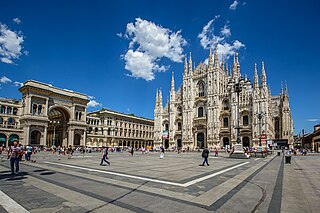
Piazza del Duomo is the main piazza of Milan, Italy. It is named after, and dominated by, Milan Cathedral. The piazza marks the center of the city, both in a geographic sense and because of its importance from an artistic, cultural, and social point of view. Rectangular in shape, with an overall area of 17,000 m2, the piazza includes some of the most important buildings of Milan, as well some of the most prestigious commercial activities, and it is by far the foremost tourist attraction of the city.

Lorenzo Bartolini was an Italian sculptor who infused his neoclassicism with a strain of sentimental piety and naturalistic detail, while he drew inspiration from the sculpture of the Florentine Renaissance rather than the overpowering influence of Antonio Canova that circumscribed his Florentine contemporaries.

The Victor Emmanuel II National Monument, also known as the Vittoriano or Altare della Patria, is a large national monument built between 1885 and 1935 to honour Victor Emmanuel II, the first king of a unified Italy, in Rome, Italy. It occupies a site between the Piazza Venezia and the Capitoline Hill. The monument was realized by Giuseppe Sacconi.

The Teatro Lirico Giuseppe Verdi is an opera house located in Trieste, Italy and named after the composer Giuseppe Verdi. Privately constructed, it was inaugurated as the Teatro Nuovo to replace the smaller 800-seat "Cesareo Regio Teatro di San Pietro" on 21 April 1801 with a performance of Johann Simon Mayr's Ginevra di Scozia. Initially, the Nuovo had 1,400 seats. In 1821, it became known as the Teatro Grande.
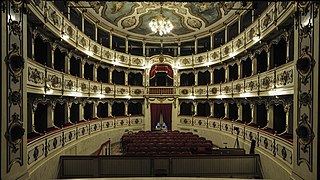
Teatro Giuseppe Verdi is a small opera house located in a wing of the Rocca dei Marchesi Pallavicino on the Piazza Giuseppe Verdi in Busseto, Italy, a town closely associated with the life of the opera composer, Giuseppe Verdi. From the 13th century, the “rocca” or “fortress” was the family's palace; it is now the city hall after being acquired by the municipality in 1856. The theatre opened on 15 August 1868 and seats 300.

The Arca di San Domenico is a monument containing the remains of Saint Dominic. It is located in Dominic’s Chapel in the Basilica of San Domenico in Bologna, Italy.
The Attacking Cavalryman Statue in Iași, Romania is a bronze monument executed by sculptor Ion Dimitriu-Bârlad and unveiled in 1927. One of the city's signature monuments, it is located in front of the SuperCopou store, across the street from the main entrance to Copou Garden.
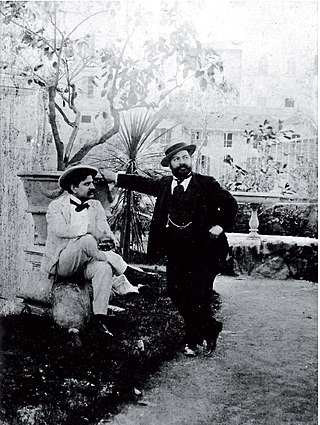
Mario Rutelli was an Italian sculptor.
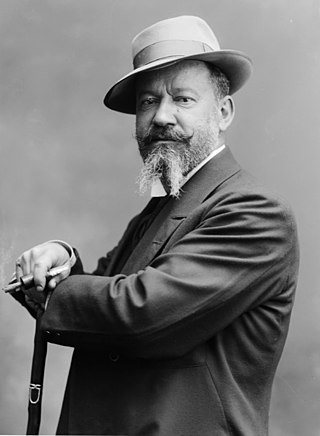
Raffaello Romanelli was an Italian sculptor, born in Florence, Italy.
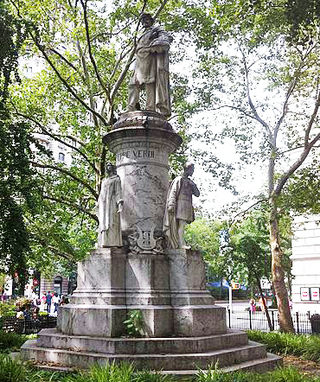
The Giuseppe Verdi Monument is a sculpture honoring composer Giuseppe Verdi in Verdi Square Park in Manhattan, New York City. The statue was created by Italian sculptor Pasquale Civiletti.

Christopher Columbus is a public artwork by Italian artist Enrico Vittori and located on the grounds of the Indiana Statehouse in Indianapolis, Indiana. The sculpture was installed on the southwest corner of the Indiana Statehouse lawn in 1920 as a gift from Italian immigrant communities in Indiana.

The General William Tecumseh Sherman Monument is an equestrian statue of American Civil War Major General William Tecumseh Sherman located in Sherman Plaza, which is part of President's Park in Washington, D.C., in the United States. The selection of an artist in 1896 to design the monument was highly controversial. During the monument's design phase, artist Carl Rohl-Smith died, and his memorial was finished by a number of other sculptors. The Sherman statue was unveiled in 1903. It is a contributing property to the Civil War Monuments in Washington, D.C. and to the President's Park South, both of which are historic sites listed on the National Register of Historic Places.

The War Memorial of Musocco is a monument commemorating the soldiers from the town of Musocco who died during the First World War. Musocco at the time was an autonomous settlement until it was incorporated into the council of Milan in 1923. The monument is located in Piazzale Santorre di Santarosa, Quartiere Varesina, and is designed as to be visible from all the four streets converging into the square.

The following is a compilation of memorials to the composer Giuseppe Verdi in the form of physical monuments and institutions and other entities named after him.
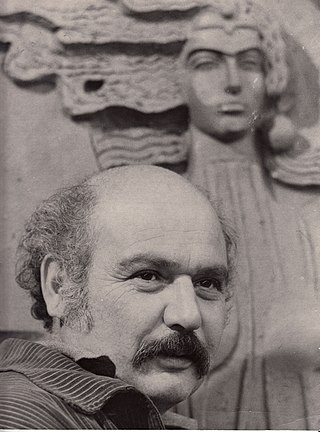
Ara Harutyunyan was an Armenian monumental sculptor, graphic artist, People's Artist of Armenia, corresponding member of Academy of Fine Arts of USSR and Russian Academy of Arts, professor.

The monument to Leonardo da Vinci is a commemorative sculptural group in the Piazza della Scala, Milan, unveiled in 1872. It is surmounted with a statue of Leonardo da Vinci, while the base has full-length figures of four of his pupils: Giovanni Antonio Boltraffio, Marco d'Oggiono, Cesare da Sesto, and Gian Giacomo Caprotti.

The Monument to the Felice Cavallotti is a marble sculpture on a plinth located Via Marina #2 in Milan, Italy. It is located just north of the facade of the Palazzo del Senato in Milan, in a pocket park that emerges south of the gardens of the Villa Belgiojoso Bonaparte. The monument was created by Italian sculptor Ernesto Bazzaro and is dedicated to tempestuous patriot, politician, journalist, and poet, Felice Cavallotti.
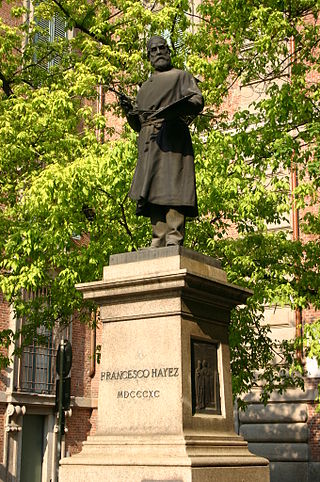
The Monument to Francesco Hayez is a bronze sculpture on a plinth located in piazzetta Brera (a small park just south of the main facade of the Brera Academy in Milan, Italy. The statue was commissioned in 1884, two years after the painter's death, from the sculptor Francesco Barzaghi, and inaugurated on 10 February 1890, on the seventh anniversary of his death.

Torquato Tamagnini was an Italian sculptor and medallist.




















